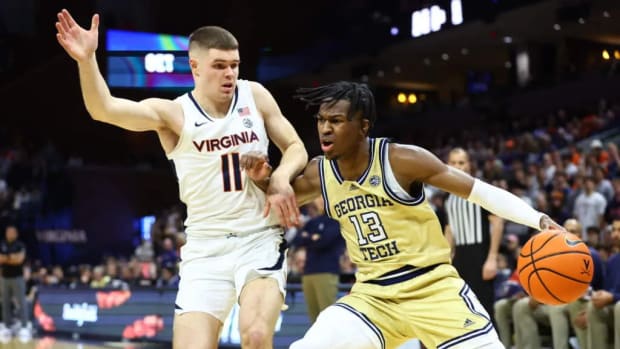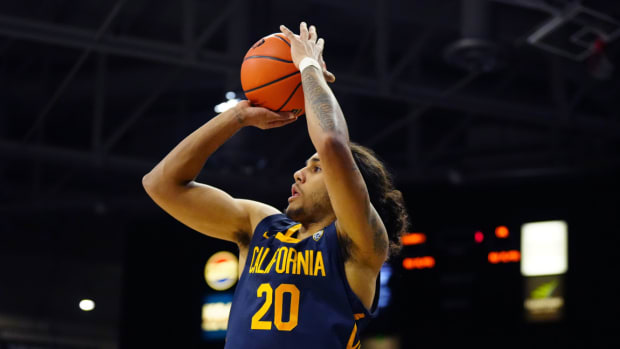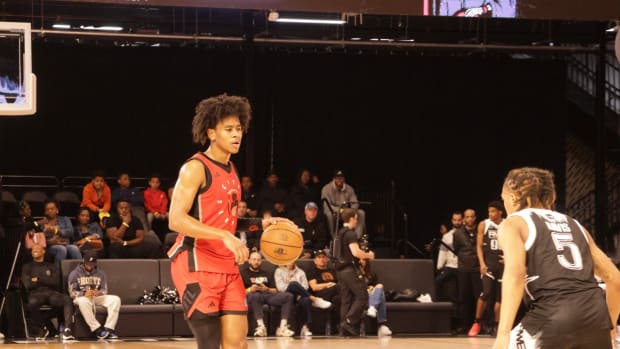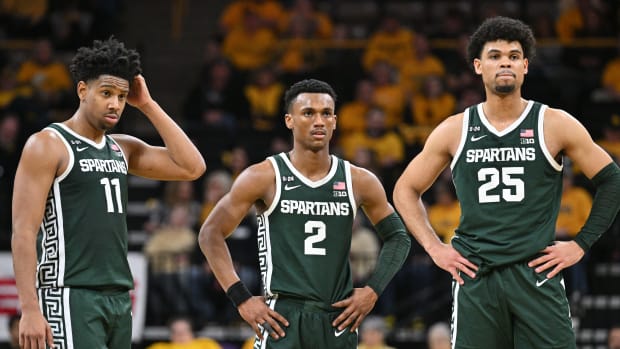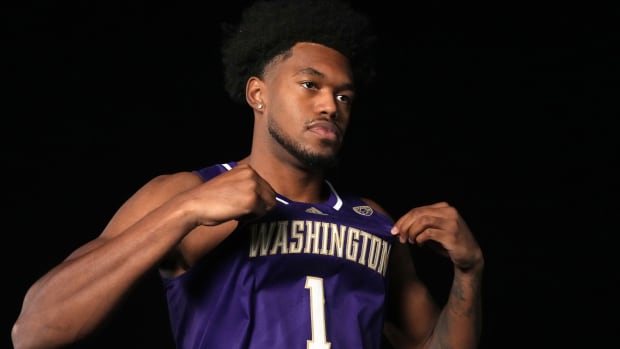Power Rankings: The Sweet Sixteen
The Power Rankings: back by popular demand ... and my editor's demand. In this special Sweet 16 Edition, the product of an all-nighter in New Orleans, teams are ranked in order of their likelihood of winning the national title. As always, the order is the order, but it will barely be a topic of discussion. There are better uses for the space.
1. OHIO STATE (East No. 1)
Faces No. 4 Kentucky on Friday in Newark
The Buckeye Graduates, from left to right: David Lighty, Dallas Lauderdale, Jon Diebler and Nikola Kecman. (@OSUADAthComm on Twitter)
It's every college student's dream -- no matter the school, no matter the state -- to have a remote graduation ceremony in Cleveland, preferably on the court of the worst franchise in the NBA, with barely anyone in the arena. Buckeyes seniors David Lighty, Dallas Lauderdale, Jon Diebler and Nikola Kecman got to live that dream on Sunday, in the shootaround prior to their third-round rout of George Mason. Michelle Willis, Ohio State's Sr. Associate Director of Athletics, surprised the four graduates with their caps and diplomas in a private, mock ceremony, which was held to make up for the fact that they were missing the real thing in Columbus. As much as we kid about Cleveland, it was a truly special day for Lighty, who grew up there; he got his degree and went out and scored 25 points on 7-of-7 three-point shooting. He'd actually had to sweat over his academic work; as Tim Layden detailed (and Pablo Torre reported) in this week's SI story about the first week of the tourney, Lighty handed in his final exam -- an online test for CSCFMFNS 644, or Quantitative Methods in Consumer Affairs -- at 10 p.m. Thursday in the team hotel, two hours before it was due. "Every day my coaches were yelling at me, 'Finish! You haven't turned the thing in yet?!' " Lighty said. "I just wanted to make sure I got every question right." He received a B+, with 62 points out of a possible 75.
All the talk about diplomas inspired me to investigate a senior question: Which Sweet 16 teams had the highest percentage of minutes played by seniors in 2010-11? The Buckeyes, even with all the PT they give to freshmen Jared Sullinger, Aaron Craft and Deshaun Thomas, rank fifth out of 16:
2. KANSAS (Southwest No. 1)
Faces No. 12 Richmond on Friday in San Antonio
I sat in on a series of film and Xs-and-Os sessions for SI's tournament preview story on offensive adaptation, and one of the most enlightening was with KU's Bill Self, who detailed ball-screen strategies involving the Morris Twins. Self runs an efficient, high-low motion offense that relies heavily on ball-screening action late in possessions, and having two versatile forwards like Marcus and Markieff Morris gives the Jayhawks plenty of options. We discussed 5-6 different screening scenarios, but the "one-game" -- which Self diagrams on his office whiteboard -- was my favorite:
[wpvideo DKWjYS7X w=590]
While I couldn't find an exact enactment of that "one-game" strategy in KU's third-round win over Illinois, I took screengrabs of a different Morrii ball-screen play that was equally effective. In frame 1 below, Marcus sets a high-side ballscreen for Brady Morningstar on the right wing in a secondary break situation. Markieff, who's a 42.1 percent three-point shooter, is in his customary (and deadly) position as a trailer, looking for an open long-range shot. His presence draws Illinois' five-man, Mike Tisdale, away from the basket, which means in frame 2, when Marcus rolls to the basket and receives a bounce-pass from Morningstar, there's an open lane to the rim for a dunk (frame 3).
3. DUKE (West No. 1)
Faces No. 5. Arizona on Thursday in Anaheim
Few players suffered through steeper declines this season than Blue Devils shooting guard Andre Dawkins, who was on top of the world -- with one of the nation's best offensive ratings (150-plus) and a major spot in Duke's rotation -- when Kyrie Irving went out with a toe injury on Dec. 4. My initial thought was that Dawkins would be fine without Irving; when the super-frosh got hurt, he had 41 assists and only four were to Dawkins, while Nolan Smith had 40 at the time and 10 (the most of any player) were to Dawkins. This was a visualization of the two point guards' assist distributions at the time (thicker line = more assists, and Dawkins is at the bottom):
In Duke's first game without Irving, Dawkins went out and scored a career-high 28 points against Bradley, on 8-of-14 three-point shooting. It seemed like he might thrive without Irving. But Dawkins' offensive rating (in points/100 possessions) would start to take a nose-dive in January, followed by his minute percentage as he fell out of favor with Coach K. These two Statsheet.com graphs illustrate the progression:
Why am I obsessing over Dawkins' negatives? Because I have a hunch he's about to break out in Anaheim, now that Irving is back in the fold. Dawkins has been showing signs of life recently; the 26 minutes he played against Michigan were his most since Feb. 16, and he's 7-of-15 on threes in his past three games. I have a feeling he has a 15-plus-point game in him out West, something he hasn't done since Jan. 2.
4. WISCONSIN (Southeast No. 4)
Faces No. 8 Butler on Thursday in New Orleans
After Wisconsin's third-round win over Kansas State, in which reserve forward Mike Bruesewitz, the Badgers' carrot-fro'd Minnesotan, battled through a knee injury to score 11 points and grab six rebounds in 29 minutes, Wildcats coach Frank Martin had some high praise for him. "I don't recruit Minnesota," Martin reportedly said, "but if you have a brother, I'm coming after him."
Bruesewitz does have a brother, but he's a 25-year-old former Princeton offensive lineman, and he was the inspiration for the tournament's best haircut:
[wpvideo PPEODPcA w=590]
5. SAN DIEGO STATE (West No. 2)
Faces No. 3 UConn on Thursday in Anaheim
After the Aztecs beat Temple in Tucson to lock up a trip to the Sweet 16, their fans at the McKale Center began chanting "We Want Kem-ba!" in reference to UConn's scoring star. SDSU reserve Tim Shelton cringed when he heard about this afterwards, telling SI's George Dohrmann, "Oh, man, they did that one game before we played BYU and Jimmer killed us. They are into it, they want the best, I understand. But it's not like you've got to give Kemba more motivation. He's motivated. He's going to be ready. He's Kemba."
Now, Temple's Juan Fernandez is no Kemba Walker, but SDSU did a fine job of shutting down Fernandez on Saturday. After he scored 23 points against Penn State in the second round, he was held to 14 -- on 1-of-10 shooting from inside the arc! -- by the Aztecs. Their ability to contest shots by penetrating guards should give them a fighting chance against the Huskies, especially if Walker's shot chart looks anything like Fernandez's from the third round (JS = jump shot, LU = layup; makes are filled in, misses are clear):
6. BYU (Southeast No. 3)
Faces No. 2 Florida on Thursday in New Orleans
This Jimmer picture, taken by SI's Robert Beck with a remote camera positioned at the base of a press-row table, is unreal ... and it rightly became our cover image this week:
When announcers say that San Diego State wants/needs to rely on transition points, it's a fallacy; the Aztecs are in the middle of the pack nationally in terms of "desire to run." The Mountain West team that does want/need to get out in the open court is BYU, which, according to Synergy Sports Technology, has the highest percentage of transition possessions of any Sweet 16 team, at 21.5 percent. The following is a chart of Synergy transition/halfcourt splits for the Sweet 16; consider it your Guide to Who Actually Runs:
7. NORTH CAROLINA (East No. 2)
Faces No. 11 Marquette on Friday in Newark
The Tar Heels are fighting the experience gap. The chart in the Ohio State section showed just how few minutes UNC has allotted to seniors this season; when that study is expanded to include minutes by seniors and juniors, UNC is still dead last. The biggest leaper from chart 1 to chart 2 is Roy Williams' old club, Kansas, which was 10th in senior minutes but third in junior-senior minutes. I'm not willing to pick the Jayhawks to lose to Richmond in the Sweet 16, but if it happens, the fact that the Spiders are No. 1 on both charts will be a major factor.
8. KENTUCKY (East No. 4)
Faces No. 1 Ohio State on Friday in Newark
Brandon Knight is a star of this NCAA tournament, but he's vastly different than John Wall, the point guard who preceded him in the John Calipari Empire. I created the following visualization using Synergy Sports Technology possession data for Knight and Wall; note the huge gap in transition usage between the two, as well as Knight's heightened reliance on the trio of pick and rolls, handoffs and off-ball screens:
9. FLORIDA (Southeast No. 2)
Faces No. 3 BYU on Thursday in New Orleans
Some statistical projections of the Sweet 16 make the Gators seem more like an underdog than the highest seed remaining in their region.
• Basketball Prospectus' Log5 projections, compiled by Ken Pomeroy, give the Gators a 43.6 percent chance of making the Elite Eight and an 18.8 percent chance of making the Final Four (the seventh-highest percentage of remaining teams).
• Compare that to Kansas, the high seed remaining in the Southwest Region: Phog Blog collected a list of the Jayhawks' probabilities that give them at minimum a 79.0 percent chance of the Elite Eight and 64.4 percent chance of the Final Four. Log5 gives KU an 81.1 chance of the Elite Eight and a 66.3 percent chance of the Final Four. Ohio State's Final Four odds are at 62.0 percent and Duke's are at 56.5 percent.
• Nate Silver's projections on New York Times' Web site are kinder to Florida, giving Erving Walker & Co. a 59.5 percent chance of beating BYU and a 33.8 percent chance of reaching the Final Four -- but also give Wisconsin an equal 33.8 percent chance of making it to Houston. Silver gives Florida a 4.5 percent chance of winning it all, which is significantly higher than Log5's championship odds of 2.0 percent.
10. UCONN (West No. 3)
Faces No. 2 San Diego State on Thursday in Anaheim
Contrary to what was expected after their five-games-in-five-days run through the Big East tournament, the Huskies' performance in the second and third rounds of the NCAAs was anything but tired. Crashing the Dance ran Net Efficiency Margin numbers for the tourney thus far -- NEM is a competition-adjusted stat that measures how well a team performed compared to a hypothetical, baseline average -- and UConn ranks third overall, only behind Ohio State and VCU. The Huskies had the fourth-best offensive performance of any team in the bracket, and the seventh-best defensive performance. The top eight teams are listed below, with the most surprising one being Michigan at No. 4; the Wolverines fell one shot short against Duke, but they were statistically stronger than the Blue Devils over two games. I imagine it's hard to take solace in that, but still ... it's something.
11. BUTLER (Southeast No. 8 )
Faces No. 4 Wisconsin on Thursday in New Orleans
Josh Levin's deconstruction of the end of the Butler-Pitt game on Slate.com was one of the better pieces of the tourney's first week, in part due to its section about Shelvin Mack's attempt to psych out Gilbert Brown during the clock review that preceded his final two free throws. The Bulldogs have a choir-boyish image nationally, but Mack has acquired a swagger and is known within the Horizon League for his chatter. Here, he was hoping to be a distraction:
With Brown having to wait around, Butler turns to psychological warfare. "We were just trying to psych him out," Smith explains. "We were just standing there looking at him." In the lane, two feet in front of Brown's face, Mack tries to make conversation. "I just asked him where he was from," Mack says, to laughter in the press room. "I told him I was from Lexington. I have a 3.0 [grade point average]. Stuff like that."
The other part I loved was how Stevens wouldn't reveal the details of the inbounds play he drew up in the event Brown hit the second free throw. As Levin wrote:
1.4 seconds to go, score tied 70-70: Butler now has to prepare for the worst: a potential one-point deficit, no timeouts, length of the floor to go. "Coach drew up a play, and so in my mind, I'm just telling myself, 'This is gonna work, this is gonna work. Even if he makes two, this is gonna work. It'll be fine,' " Howard remembers.
But the Bulldogs' plan is sketchy. "We were just going to have to throw it deep," Stevens recalls, "cut guys different ways and choose one."
There's a reason Stevens didn't go into detail: He wants to use that play again -- and there's no sense in talking about something that opponents don't yet have on film. All they know now is that reserve Erik Fromm is the intended inbounder. The rest is still a secret.
12. ARIZONA (West No. 5)
Faces No. 1 Duke on Thursday in Anaheim
Efficiency in after-timeout situations is of heightened importance (or at the very least, under higher scrutiny) in the NCAA tournament, and Texas' inability to even inbound the ball at a critical moment helped the Wildcats reach the Sweet 16. If Arizona has one distinct advantage over everyone else left in the bracket -- other than having Derrick Williams, that is -- it's that coach Sean Miller has been excellent in setting up scoring plays out of timeouts, averaging 1.001 points per possession. According to Synergy Sports Technology, this is how the Sweet 16 teams ranked on the season in after-timeout efficiency:
13. FLORIDA STATE (Southwest No. 10)
Faces No. 11 VCU on Friday in San Antonio
Things the Seminoles' defense did to Notre Dame's offense, which Synergy had ranked as the most efficient half-court attack in the nation:
• Held the Irish to 0.916 points per possession, their lowest total since a Jan. 16 loss to St. John's. Their adjusted season average is 1.212 PPP.
• Held the Irish to an effective FG% (which is weighted to properly address three-pointers) of 36.3, their lowest since a Nov. 26 win over Cal. Their season-average eFG% is 53.5.
• Held Carleton Scott to 1-of-10 shooting and an offensive rating of 39.9 -- by far his lowest of the entire season. His season O-Rating was 117.7.
VCU's offense, according to the NEM figures, was the most efficient of any team in the bracket over two games ... but it's running into the Seminoles' D, which was by far the most efficient through two games. Something will have to give, and I suspect that it will be the Rams' otherworldly shooting percentage.
14. MARQUETTE (East No. 11)
Faces No. 2 North Carolina on Friday in Newark
This Gary Parrish column alerted me to the fact that Buzz Williams is slightly obsessive about Synergy scouting, because it included the following press-conference quote about Xavier's reliance on the ball screen:
"Then [another] 42 percent of their points as a team come from the ball screen, and from only the two guys involved in the ball screen. ... Only the two guys involved in the ball screen constitute 42 percent of Xavier's points, and of that 42 percent Tu Holloway is involved in it 63 percent of the time, and it's really dangerous because he does such an effective job of using the ball screen that he forces help. And a lot of times when he forces help he gets fouled, but he also puts your team in constant rotation because of the ball screen and the coverage of the ball screen. They set multiple ball screens per possession. So Tu Holloway literally may in one possession get three ball screens by three different players. And I don't study any other teams other than the ones we play, but I would say that he probably gets more ball screens than any player in the country, and I'm not sure he wouldn't be deemed the most effective from those ball screens."
That was actually only about half of Buzz's answer, but you get the idea: The guy analyzed the hell out of the way Holloway uses screens, and then devised a plan to take Holloway out of the game. He scored just five points, 15 under his average, and took just eight shots, making one. "I don't know [what happened]," Holloway said. "I really couldn't figure it out."
I tried to figure out what Marquette did, exactly, on those ball screens. This first grid of four images depicts how the Golden Eagles defended Xavier's first ballscreen of that game. As you can see in frames 2 and 3, the screener's defender jumps out to hedge -- and then sticks with Holloway in a double-team all the way to the opposite wing, only leaving him once he's given up the ball:
This second screengrab series shows how Marquette defended a ballscreen for Mark Lyons in the first half; the screener's defender sat on the high side, blocking penetration to the middle, and then Kenny Frease's defender sagged back to the rim to protect against a slipped screen. That freed up both pick-and-roll defenders to double-team Lyons, and he, too, gave up the ball.
15. RICHMOND (Southwest No. 12)
Faces No. 1 Kansas on Friday in San Antonio
Yet another reason to think the Spiders might have a chance against KU: They have the fifth-best halfcourt offense left in the tournament, averaging 0.953 PPP on the season, and they turn the ball over in halfcourt situations less than Kansas does (14.1 percent to 15.8 percent). According to Synergy Sports Technology, this is how the remaining 16 teams rank in halfcourt efficiency (PPP):
16. VCU (Southwest No. 11)
Faces No. 10 Florida State on Friday in San Antonio
Young Rams coach Shaka Smart is the breakout sideline star of this tournament, and it seems that some major-conference athletic director will go the predictable "Hire a Mid-Major Coach Who Just Went to the Sweet 16" route this offseason and make Smart a rich man. Such hires always seem like a great idea at the time -- if he could get [poorer Team X] deep in the NCAAs, he can certainly get us there -- but how often do they pan out? The following chart looks at the past 11 mid-major coaches to jump to a new job directly after reaching the Sweet 16; you'll see that three of the first four (Steve Alford, Dan Monson and Stan Heath) flopped, and only five of the 11 have reached the Sweet 16 with their new team (Bill Self, Trent Johnson, Thad Matta, Bruce Pearl and Sean Miller):












